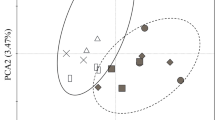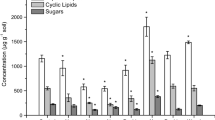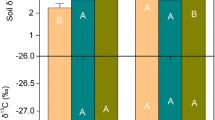Abstract
We assessed microbial community composition as a function of altered above- and belowground inputs to soil in forest ecosystems of Oregon, Pennsylvania, and Hungary as part of a larger Detritus Input and Removal Treatment (DIRT) experiment. DIRT plots, which include root trenching, aboveground litter exclusion, and doubling of litter inputs, have been established in forested ecosystems in the US and Europe that vary with respect to dominant tree species, soil C content, N deposition rate, and soil type. This study used phospholipid fatty-acid (PLFA) analysis to examine changes in the soil microbial community size and composition in the mineral soil (0–10 cm) as a result of the DIRT treatments. At all sites, the PLFA profiles from the plots without roots were significantly different from all other treatments. PLFA analysis showed that the rootless plots generally contained larger quantities of actinomycete biomarkers and lower amounts of fungal biomarkers. At one of the sites in an old-growth coniferous forest, seasonal changes in PLFA profiles were also examined. Seasonal differences in soil microbial community composition were greater than treatment differences. Throughout the year, treatments without roots continued to have a different microbial community composition than the treatments with roots, although the specific PLFA biomarkers responsible for these differences varied by season. These data provide direct evidence that root C inputs exert a large control on microbial community composition in the three forested ecosystems studied.




Similar content being viewed by others
References
AND LTER (2005) PRIMET soil temperature and moisture data set. Forest Science, Oregon State University, Corvallis. http://www.fsl.orst.edu/lter/data.cfm?topnav=8
Bligh EG, Dyer WJ (1959) A rapid method of total lipid extraction and purification. Can J Biochem Physiol 37:911–917
Blume E, Bischoff M, Reichert JM, Moorman T, Konopka A, Turco RF (2002) Surface and subsurface microbial biomass, community structure and metabolic activity as a function of soil depth and season. Appl Soil Ecol 20:171–181
Bohlen PJ, Edwards CA, Zhang Q, Parmelee RW, Allen M (2002) Indirect effects of earthworms on microbial assimilation of labile carbon. Appl Soil Ecol 20:255–261
Boone RD, Nadelhoffer KJ, Canary JD, Kaye J (1998) Roots exert a strong influence on the temperature sensitivity of soil respiration. Nature 396:570–572
Bossio DA, Scow KA (1998) Impacts of carbon and flooding on soil microbial communities: phospholipid fatty acid profiles and substrate utilization patterns. Microb Ecol 35:265–278
Bossio DA, Scow KM, Gunapala N, Graham KJ (1998) Determinants of soil microbial communities: effects of agricultural management, season, and soil type on phospholipid fatty acid profiles. Microb Ecol 36:1–12
Bowden RD, Nadelhoffer KJ, Boone RD, Melillo JM, Garrison JB (1993) Contributions of aboveground litter, belowground litter, and root respiration to total soil respiration in a temperature mixed hardwood forest. Can J Forest Res 23:1402–1407
Butler JL, Bottomley PJ, Griffith SM, Myrold DD (2004) Distribution and turnover of recently fixed photosynthate in ryegrass rhizospheres. Soil Biol Biochem 36:371–382
Dixon JJ (2003) Applying GIS to soil geomorphologic landscape mapping in the Lookout Creek valley, Western Cascades, Oregon. MS Thesis, Oregon State University, Department of Crop and Soil Science, Corvallis, OR
Fierer N, Schimel JP, Holden PA (2003) Variations in microbial community composition through two soil depth profiles. Soil Biol Biochem 35:167–176
Fisk MC, Fahey TJ (2001) Microbial biomass and nitrogen cycling responses to fertilization and litter removal in young northern hardwood forests. Biogeochemistry 53:201–223
Fritze H, Pietikainen J, Pennanen T (2000) Distribution of microbial biomass and phospholipid fatty acids in Podzol profiles under coniferous forest. Eur J Soil Sci 51:565–573
Griffiths BS, Ritz K, Ebblewhite N, Dobson G (1999) Soil microbial community structure: effects of substrate loading rates. Soil Biol Biochem 31:145–153
Hill GT, Mitkowski NA, Aldrich-Wolfe L, Emele LR, Jurkonie DD, Ficke A, Maldonado-Ramirez S, Lynch ST, Nelson EB (2000) Methods for assessing the composition and diversity of soil microbial communities. Appl Soil Ecol 15:25–36
Holland EA, Braswell BH, Sulzman JM, Lamarque J-F (2004) Nitrogen deposition onto the United States and Western Europe. In. ORNL DAAC, Oak Ridge. http://www.daac.ornl.gov
Keirstead H (2004) Quantifying C and N contents and isotopic signatures of SOM pools in the H.J. Andrews DIRT plots. MS Thesis, Oregon State University, Department of Crop and Soil Science, Corvallis, OR
Kieft TL, Wilch E, O’Connor K, Ringelberg DB, White DC (1997) Survival and phospholipid fatty acid profiles of surface and subsurface bacteria in natural sediment microcosms. Appl Environ Microbiol 63:1531–1542
Kruskal JB (1964) Nonmetric multidimentional scaling: a numerical method. Psychometrika 29:115–129
Lajtha K, Crow S, Yano Y, Kaushal SS, Sulzman EW, Spears JDH (2005) Detrital controls on soil solution N and dissolved organic matter in soils: a field experiment. Biogeochemistry 76:261–268
Langley JA, Hungate BA (2003) Mycorrhizal controls on belowground litter quality. Ecology 84:2302–2312
Lavigne MB, Foster RJ, Goodine G (2004) Seasonal and annual changes in soil respiration in relation to soil temperature, water potential and trenching. Tree Physiol 24:415–424
Leckie SE (2005) Method of microbial community profiling and their application to forest soils. Forest Ecol Manage 220:88–106
Li YQ, Xu M, Sun OJ, Cui WC (2004) Effects of root and litter exclusion on soil CO2 efflux and microbial biomass in wet tropical forests. Soil Biol Biochem 36:2111–2114
Litton CM, Ryan MG, Knight DH, Stahl PD (2003) Soil-surface carbon dioxide efflux and microbial biomass in relation to tree density 13 years after a stand replacing fire in a lodgepole pine ecosystem. Glob Change Biol 9:680–696
Lundquist EJ, Scow KM, Jackson LE, Uesugi SL, Johnson CR (1999) Rapid response of soil microbial communities from convertional low input, and organic farming systems to a wet/dry cycle. Soil Biol Biochem 31:1661–1675
Macdonald LM, Paterson E, Dawson LA, McDonald AJS (2004) Short-term effects of defoliation of the soil microbial community associated with two contrasting Lolium perenne cultivars. Soil Biol Biochem 36:489–498
Mather PM (1976) Computation methods of multivariate analysis in physical geography. Wiley, London
McCarthy AJ, Williams ST (1992) Actinomycetes as agents of biodegredation in the environment: a review. Gene 115:189–192
McCune B, Grace JB (2002) Analysis of ecological communities. MjM Software Design, Gleneden Beach, OR
McCune B, Mefford MJ (1999) Multivariate analysis on the PC-ORD system. Version 4. MjM Software, Gleneden Beach, OR
Mielke PW Jr (1984) Meterological applications of permutation techniques based on distance functions. In: Krishnaiah PR, Sen PK (eds) Handbook of statistics, vol 4. Elsevier Science Publishers, New York
Mielke PW Jr, Berry KJ (2001) Permutation methods: a distance function approach. Springer, Berlin Heidelberg New York
Myers RT, Zak DR, White DC, Peacock A (2001) Landscape-level patterns of microbial community composition and substrate use in upland forest ecosystems. Soil Sci Soc Am J 65:359–367
Nadelhoffer KJ, Boone RD, Bowden RD, Canary JD, Kaye J, Micks P, Ricca A, Aitkenhead JA, Lajtha K, McDowell WH (2004) The DIRT experiment: litter and root influences on forest soil organic matter stocks and function. In: Foster D, Aber J (eds) Forest landscape dynamics in New England: ecosystem structure and function as a consequence of 5000 years of change. Oxford University Press, New York
Olsson PA, Johansen A (2000) Lipid and fatty acid composition of hyphae and spores of arbuscular mycorrhizal fungi at different growth stages. Mycorrhizal Res 104:429–434
Rey A, Pegoraro E, Tedeschi V, De Parri I, Jarvis PG, Valentini R (2002) Annual variation in soil respiration and its components in a coppice oak forest in central Italy. Glob Change Biol 8:851–866
Schimel DS (1995) Terrestrial ecosystems and the carbon cycle. Glob Change Biol 1:77–91
Schimel JP, Gulledge JM, Clein-Curley JS, Lindstrom JE, Baddock JF (1999) Moisture effects on microbial activity and community structure in decomposing birch litter in the Alaskan taiga. Soil Biol Biochem 31:831–838
Siira-Pietikainen A, Haimi J, Kanninen A, Pietikainen J, Fritze H (2001) Responses of decomposer community to root-isolation and addition of slash. Soil Biol Biochem 33:1993–2004
Siira-Pietikainen A, Haimi J, Fritze H (2003) Organisms, decomposition, and growth of pine seedlings in boreal forest soil affected by sod cutting and trenching. Biol Fertil Soil 37:163–174
Simard SW, Perry DA, Smith JE, Molina R (1997) Effects of soil trenching on occurrence of ectomycorrhizas on Pseudotsuga menziesii seedlings grown in mature forests of Betula papyrifera and Pseudotsuga menziesii. New Phytol 136:327–340
Smith JL, Paul EA (1990) The significance of soil microbial biomass estimations. In: Bollag J, Stotsky G (eds) Soil biochemistry, vol 8. Mercel Dekker, New York, pp 357–393
Spears JDH, Holub SM, Harmon ME, Lajtha K (2003) The influence of decomposing logs on soil biology and nutrient cycling in an old-growth mixed coniferous forest in Oregon, USA. Can J Forest Res 33:2193–2201
Subke J-A, Hahn V, Battipaglia G, Linder S, Buchmann N, Cotrufo MF (2004) Feedback interactions between needle litter decomposition and rhizosphere activity. Oecologia 139:551–559
Sulzman EW, Brant JB, Bowden RD, Lajtha K (2005) Contribution of aboveground litter, belowground litter, and rhizosphere respiration to total soil CO2 efflux in an old growth coniferous forest. Biogeochemistry 73:231–256
Tingey DT, Phillips DL, Johnson MG, Rygiewicz PT, Beedlow PA, Hogsett WE (2005) Estimates of Douglas-fir fine root production and mortality from minirhizotrons. Forest Ecol Manage 204:359–370
Vanderbilt KL, Lajtha K, Swanson FJ (2003) Biogeochemistry of unpolluted forest watersheds in Oregon Cascades: temporal patterns of precipitation and stream nitrogen fluxes. Biogeochemistry 62:87–117
Wallander H, Nilsson L-O, Hagerberg D, Bååth E (2001) Estimation of the biomass and seasonal growth of external mycelium of ectomycorrhizal fungi in the field. New Phytol 151:753–760
Waring RH, Franklin JF (1979) Evergreen coniferous forests of the Pacific Northwest. Science 204:1380–1386
White DC, Ringelberg DB (1998) Signature biolipid biomarker analysis. In: Burlage RS et al (eds) Techniques in microbial ecology. Oxford University Press, New York, pp 255–272
Wiemken V, Laczko E, Ineichen K, Boller T (2001) Effects of elevated carbon dioxide and nitrogen fertilization on mycorrhizal fine roots and the soil microbial community in beech-spruce ecosystems on siliceous and calcareous soil. Microb Ecol 42:126–135
Wilkinson SC, Anderson JM, Scardelis SP, Tisiafouli M, Taylor A, Wolter V (2002) PLFA profiles of microbial communities in decomposing conifer litters subject to moisture stress. Soil Biol Biochem 34:189–200
Yano Y, Lajtha K, Sollins P, Caldwell B (2005) Chemical and seasonal controls on the dynamics of dissolved organic matter in a coniferous old-growth stand in the Pacific Northwest, USA. Biogeochemistry 71:197–223
Zak D, Pregitzer K, Curtis P, Homes W (2000) Atmospheric CO2 and the composition and function of soil microbial communities. Ecol Appl 10:47–59
Acknowledgements
This project was supported in part by funds from the Oregon Agricultural Experiment Station. NSF’s LTER program provided funds to maintain the experimental treatments. We thank S. Kageyama for help with field work, J. Moore Kucera for assistance with PLFA extraction and interpretation, S. Crow for statistical help, R. Bowden for collecting the BOU soil cores, B. Caldwell for collecting the SIK soil cores, and R. Yarwood for analytical assistance. Finally, we thank K. Lajtha and B. Caldwell for useful discussions.
Author information
Authors and Affiliations
Corresponding author
Additional information
Communicated by Jim Ehleringer
Rights and permissions
About this article
Cite this article
Brant, J.B., Myrold, D.D. & Sulzman, E.W. Root controls on soil microbial community structure in forest soils. Oecologia 148, 650–659 (2006). https://doi.org/10.1007/s00442-006-0402-7
Received:
Accepted:
Published:
Issue Date:
DOI: https://doi.org/10.1007/s00442-006-0402-7




